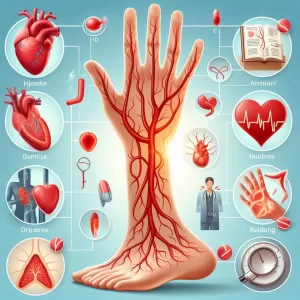ما هي متلازمة النفق الرسغي (CTS)؟
**What is Carpal Tunnel Syndrome (CTS)?**
**Definition**
Carpal tunnel syndrome (CTS) is a medical condition that affects the median nerve, which runs through a narrow passageway in the wrist known as the carpal tunnel.
**Causes**
CTS occurs when the tissues surrounding the tendons in the carpal tunnel become inflamed, causing pressure on the median nerve. This can be caused by repetitive hand movements, obesity, pregnancy, and certain medical conditions such as diabetes or rheumatoid arthritis.
**Symptoms**
* Numbness, tingling, or pain in the palm of the hand, thumb, index, middle, and ring fingers
* Weakness in the hand, making it difficult to grasp objects or make a fist
* Shooting pain that extends up the forearm
* A burning or prickling sensation in the fingers
* Numbness or weakness that is worse at night or after prolonged hand use
**Diagnosis**
CTS is typically diagnosed through a physical exam and a series of tests, including:
* Wrist flexion and extension tests
* Tinel’s test (tapping over the median nerve)
* Phalen’s test (flexing the wrists for 60 seconds)
* Electrodiagnostic studies (EMG and nerve conduction studies)
**Treatment**
Treatment for CTS aims to reduce pressure on the median nerve and alleviate symptoms. Options include:
* **Non-surgical Treatment:**
* Wrist splints or braces to immobilize the wrist
* Physical therapy
* Ergonomic modifications to reduce hand strain
* Over-the-counter pain relievers (e.g., ibuprofen, naproxen)
* **Surgical Treatment:**
* Carpal tunnel release, which involves cutting the ligament and creating more space in the carpal tunnel
**Long-Term Outlook**
With proper treatment, most people with CTS experience significant improvement or complete resolution of symptoms. However, early diagnosis and intervention are key to preventing permanent nerve damage.
**Prevention**
While not all cases of CTS are preventable, there are steps you can take to reduce your risk:
* Take breaks from repetitive hand movements
* Use ergonomic tools and postures
* Wear wrist braces or splints during activities that strain your wrists
* Maintain a healthy weight
* Manage underlying medical conditions that contribute to CTS (e.g., diabetes, obesity)
**Additional Information**
* CTS is the most common entrapment neuropathy in the upper extremity.
* It affects women more frequently than men.
* The severity of CTS can vary from mild to severe, with some individuals experiencing only occasional discomfort and others experiencing debilitating pain.
* In severe cases, CTS can lead to loss of function in the hand and difficulty with everyday activities.
تعليق واحد
اترك ردّاً
المقالات الشعبية






This is a great question! I’m not sure what Carpal Tunnel Syndrome is, but I’m sure someone else can help you out.